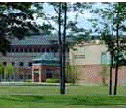




















|
|
Particle Deposition Mechanisms: Impaction Cyclone Separator Cyclones are used for removal of particles with diameter more than a few microns from gases. Gas enters from the side and acquires a rotational speed. Particles are moved towards the wall due to centrifugal forces.Radial force balance for a particle in the rotating flow in a cyclone is given as
For small particles,
or
where It is assumed that
Equation (3) then becomes
or
The number of turns needed to deposit the particles of size d (that is, moving the particles from the radius a to the side wall at r=b) is given by
or
Alternatively, the smallest particle that can be
removed in
In practice, an approximate expression
is used, where U is the mean inlet velocity. |


|



 , it
follows that
, it
follows that


 is used.
is used.





 turns is given by
turns is given by

